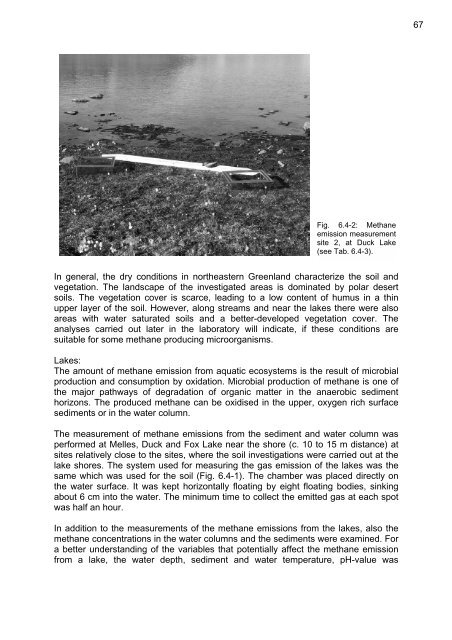the Expedition ARKTIS-XIX/4 of the research vessel POLARSTERN ...
the Expedition ARKTIS-XIX/4 of the research vessel POLARSTERN ...
the Expedition ARKTIS-XIX/4 of the research vessel POLARSTERN ...
You also want an ePaper? Increase the reach of your titles
YUMPU automatically turns print PDFs into web optimized ePapers that Google loves.
Fig. 6.4-2: Methane<br />
emission measurement<br />
site 2, at Duck Lake<br />
(see Tab. 6.4-3).<br />
In general, <strong>the</strong> dry conditions in nor<strong>the</strong>astern Greenland characterize <strong>the</strong> soil and<br />
vegetation. The landscape <strong>of</strong> <strong>the</strong> investigated areas is dominated by polar desert<br />
soils. The vegetation cover is scarce, leading to a low content <strong>of</strong> humus in a thin<br />
upper layer <strong>of</strong> <strong>the</strong> soil. However, along streams and near <strong>the</strong> lakes <strong>the</strong>re were also<br />
areas with water saturated soils and a better-developed vegetation cover. The<br />
analyses carried out later in <strong>the</strong> laboratory will indicate, if <strong>the</strong>se conditions are<br />
suitable for some methane producing microorganisms.<br />
Lakes:<br />
The amount <strong>of</strong> methane emission from aquatic ecosystems is <strong>the</strong> result <strong>of</strong> microbial<br />
production and consumption by oxidation. Microbial production <strong>of</strong> methane is one <strong>of</strong><br />
<strong>the</strong> major pathways <strong>of</strong> degradation <strong>of</strong> organic matter in <strong>the</strong> anaerobic sediment<br />
horizons. The produced methane can be oxidised in <strong>the</strong> upper, oxygen rich surface<br />
sediments or in <strong>the</strong> water column.<br />
The measurement <strong>of</strong> methane emissions from <strong>the</strong> sediment and water column was<br />
performed at Melles, Duck and Fox Lake near <strong>the</strong> shore (c. 10 to 15 m distance) at<br />
sites relatively close to <strong>the</strong> sites, where <strong>the</strong> soil investigations were carried out at <strong>the</strong><br />
lake shores. The system used for measuring <strong>the</strong> gas emission <strong>of</strong> <strong>the</strong> lakes was <strong>the</strong><br />
same which was used for <strong>the</strong> soil (Fig. 6.4-1). The chamber was placed directly on<br />
<strong>the</strong> water surface. It was kept horizontally floating by eight floating bodies, sinking<br />
about 6 cm into <strong>the</strong> water. The minimum time to collect <strong>the</strong> emitted gas at each spot<br />
was half an hour.<br />
In addition to <strong>the</strong> measurements <strong>of</strong> <strong>the</strong> methane emissions from <strong>the</strong> lakes, also <strong>the</strong><br />
methane concentrations in <strong>the</strong> water columns and <strong>the</strong> sediments were examined. For<br />
a better understanding <strong>of</strong> <strong>the</strong> variables that potentially affect <strong>the</strong> methane emission<br />
from a lake, <strong>the</strong> water depth, sediment and water temperature, pH-value was<br />
67

















